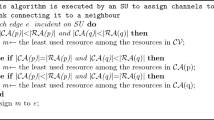Abstract
Network-assisted diversity multiple access (NDMA) was recently proposed to resolve collision. The blind NDMA method using independent component analysis (ICA) ICA-NDMA, has been developed to overcome the difficulties of synchronization and orthogonal identification codes required by the training-based NDMA protocols. In this paper, we propose a novel blind collision resolution protocol, named as ICA-CoopNDMA, by employing cooperative transmission in ICA-NDMA. When K-node collision happened, a cooperative transmission mechanism is adopted to collect different mixtures of the K original packets in the following slots. After that, the destination can recover the original packets using ICA. This protocol offers spatial diversity by using relay nodes and is robust to the wireless channel. In order to determine the collision multiplicity K, a cooperative blind detection algorithm is also proposed based on minimum description length (MDL) criterion. This algorithm saves one detection slot compared with conventional MDL-based method used by ICA-NDMA. Hence, the delay of ICA-CoopNDMA is reduced. Simulation and theoretical analysis results show that, the proposed protocol can work effectively under both fast and slow fading channels. Compared with ICA-NDMA, the maximum stable throughput and average packet delay are obviously better, and the energy efficiency is higher under heavy traffic load.
Similar content being viewed by others
References
Liu, X., Kountouriotis, J., Petropulu, A. P., & Dandekar, K. R. (2009). ALOHA with collision resolution(ALOHA-CR): Theory and software defined radio implementation, http://arxiv.org/PS_cache/arxiv/pdf/0909/0909.3091v1.pdf. Submitted on 16 Sept.
Tsatsanis M. K., Zhang R. F., Banerjee S. (2000) Network-assisted diversity for random access wireless networks. IEEE Transactions on Signal Processing 48(3): 702–711
Zhang R. F., Sidiropoulos N. D. (2002) Collision resolution in packet radio networks using rotational invariance techniques. IEEE Transactions on Communications 50(1): 146–155
Ozgul B., Delic H. (2006) Wireless access with blind collision-multiplicity detection and retransmission diversity for quasi-static channels. IEEE Transactions on Communications 54(5): 858–867
Zhang Y., Chen H. H., Guizani M. (2009) Cooperative wireless communications. Auerbach Publications, Boston
Li, X., Zhang, Y., & Amin, M. G. (May 2008). Cooperative wireless medium access exploiting multi-beam adaptive arrays and relay selection. In IEEE International Conference on Circuits and Systems for Communications, Shanghai, China.
Dong L., Petropulu A. P. (2008) Multichannel ALLIANCES: A cooperative cross-layer scheme for wireless networks. IEEE Transactions on Signal Processing 56(2): 771–784
Bingham E., Hyvärinen A. (2000) A fast fixed-point algorithm for independent component analysis of complex valued signals. International Journal of Neural Systems 10(1): 1–8
Dimic G., Sidiropoulos N. D., Tassiulas L. (2008) Wireless networks with retransmission diversity access mechanisms: Stable throughput and delay properties. IEEE Transactions on Signal Processing 51(8): 2019–2030
Cardei M., Wu J. (2006) Energy-efficient coverage problems in wireless ad hoc sensor networks. Computer Communications 29(4): 413–420
Zheng Y. R., Xiao C. (2002) Improved models for the generation of multiple uncorrelated Rayleigh fading waveforms. IEEE Communication Letters 6(6): 256–258
Author information
Authors and Affiliations
Corresponding author
Rights and permissions
About this article
Cite this article
Yao, J., Yang, X. & Li, J. A Blind Collision Resolution Protocol Based on Cooperative Transmission. Wireless Pers Commun 64, 273–286 (2012). https://doi.org/10.1007/s11277-010-0197-z
Published:
Issue Date:
DOI: https://doi.org/10.1007/s11277-010-0197-z




